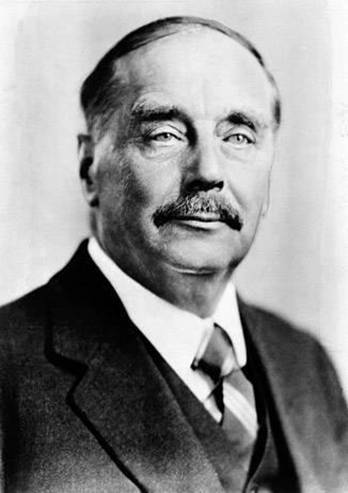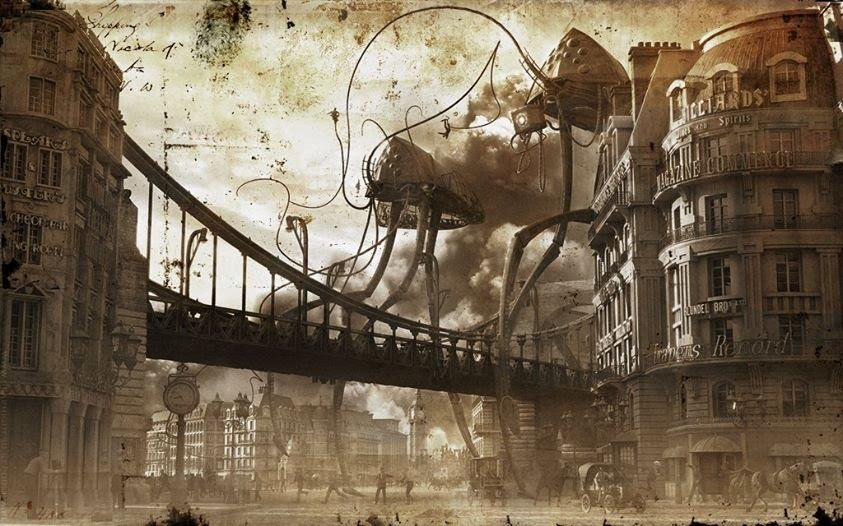The prognostic fiction of HG Wells

A scene from the movie The Time Machine (1960), based on the novel of the same name by HG Wells.
This is a real treat for science fiction lovers - yesterday, HG George Wells would have turned 150 years old. During his life he managed to do a lot, thanks to incredible perseverance and inexhaustible talent in the works and science.
Despite the fact that HG Wells lived in the time of Victorian England, when the most advanced technique was a bicycle with chain drive and inflatable tires, and the houses were lit with candles and lamps, he was able to foresee many inventions of the future. The industrial revolution and technical progress of that time allowed Wells to be inspired by the scientific discoveries of various fields. Since he was a biologist-scientist, the scientific approach was reflected in his fiction. Wells conducted scientific experiments with the future, showing the consequences of various discoveries in the present. He showed not only the side of the progress and development of mankind, but also the destructive power of technology, due to the selfish use of scientific discoveries.
Herbert George Wells's fame came through sci-fi novels and short stories, making him one of the founders of the fiction genre. A special place in his work was given to ethics, the paths of human development and the place of man in the world. In addition to the exciting imagination, his books are filled with predictions of the development of the future of science and technology. In this post we will figure out which of his predictions have become a reality.
Pioneer in fiction

Initially, critics were cold to Wells's fantastic predictions. They considered his books unscientific fantasy, but only until the writer's imagination became reality. Modern researchers of his work claim that the forecasts of the science fiction come true by almost 80 percent. A. Einstein, having read about the atomic bomb, made a statement that such an idea was unthinkable. But 30 years later, atomic bombing wiped out Hiroshima and Nagasaki.
Wells is the discoverer of many themes that have become popular and spawned many trends in contemporary fiction. These topics include:
- four-dimensional space-time;
- world wars with the use of nuclear, chemical and biological weapons;
- description of new technical inventions for waging war: aviation, tanks, lasers;
- Parallel Worlds;
- antigravity;
- invisibility effect;
- the existence of life on other planets and alien invasion;
- cryonics.
In addition, he was one of the first to foresee the social changes of the future society: globalization, the technocratic revolution, the boom in the development of information technologies, as well as the processes associated with the consequences of these phenomena.
"Time Machine"
In 1895, Wells's first novel, The Time Machine, was released. 10 years before the discoveries of A. Einstein and G. Minkowski, the possibility of the existence of four-dimensional space-time appeared in the novel .
The image of “The Time Machine” appeared in the writer after he heard the report “On the possibilities of non-Euclidean geometry” at the meeting of the discussion club based on the book “What is the fourth dimension” (1884) by C. Hinton.

In 1891, Wells wrote an essay "The Fixed Universe" in which he explained the concept of a four-dimensional world, with four coordinates: length, width, height (space) and length (time). The publisher rejected his essay because the publisher understood no more than 10 percent of what Wells wrote about.
For the first time in the novel was presented the idea of time travel, which later became very popular among writers.
The concept of technical invention - time machines excites the consciousness of scientists and writers so far.
"Invisible Man"
The next novel was - "The Invisible Man" (1897). The author described the effect of invisibility , which is fully inaccessible to modern science.

The character of the novel medical student Griffin finds a way by which light bends around his body in such a way as not to reflect from it. For writing the novel, Wells turns his attention to the study of the properties of jellyfish, which are almost imperceptible in water.
The idea of invisibility has become very attractive to American military complexes. Today stealth planes invisible for radars and a meta-material camouflage are invented.
"War of the Worlds"
The topic of alien invasion was presented for the first time in science fiction literature in the book War of the Worlds in 1898. Its creation was inspired by advanced discoveries in astronomy of the time, in particular, the research of the astronomer and mathematician Percival Lowell. As a result of observations of Mars in 1877 and 1892, astronomers were able to study it in detail: its satellites were discovered, the polar caps and the system of channels on the surface of the planet were studied. After these discoveries appeared an assumption about the possibility of the existence of life on Mars.

In addition to scientific incentives, the writing of the “War of the Worlds” was complemented by social factors: the strengthening of Germany on the world stage and the consequences of the destructive impact on the biosphere.
The book was received by the public cordially, but some were able to find in it a criticism of the colonialist policy of Great Britain.
In the novel, Wells predicted the use of weapons of mass destruction and aircraft for military purposes, which was exactly what happened during the First World War.
The War of the Worlds made a strong impression on Leo Szilard, who in the future began to develop atomic weapons. And Robert Goddart devoted his life to rocket science, inspired by the novel.
On October 30, 1938, Orson Welles' War of the Worlds radio show created a sensation and mass panic in New York because of its realism. The audio performance was transmitted in the form of radio news, because of which the residents believed in the Martian invasion of the earth. After this incident in America, the laws of broadcasting were tightened.

"Island of Dr. Moreau"
In "Island of Dr. Moreau" (1896), the author describes the consequences of genetic experiments and the cultivation of beast men. Such experiments did not give positive results in the XX century, but now research is being conducted on raising sheep that are biologically similar to humans. This allows you to grow organs for transplantation in humans.
"When the sleeper wakes up"
In the novel “When the sleeper wakes up” (1899), Wells describes a cryonics process that allows you to freeze the body in order to resurrect it in the future. Thus, there is a new way to travel to the future and increase life expectancy.
"The first people on the moon"
Dreams about space exploration led Wells to write the book The First People on the Moon (1901). The novelty of the writer was to create anti-gravity with the help of “caveport”, which allows to get rid of gravity. Traveling in this way to the moon now seems fiction, but it has acquired an unexpected twist - the creation of the future transport concept MagLev, which will “float” with the help of magnetic pillows.
"War in the air"
Published in 1908, the novel “War in the Air” anticipates the mood of the First World War using the new aviation in the form of air battles and the prediction of the war between the USA and Germany, which will take the path of world domination.

"The Liberated World"
In 1914, Wells released his book, predicting the appearance of the atomic bomb and radioactivity. The novel was written under the influence of Frederick Soddy, the Nobel Prize winner in chemistry in 1921, in which Wells creates his own radioactive element “caroline,” which became the prototype of plutonium. In addition, he described the possibility of the existence of an even more powerful hydrogen bomb.
Also in the book there are references to the date of discovery of radioactivity - 1933. In fact, the Nobel Prize for the discovery of radioactivity was awarded in 1934 to the spouses Joliot-Curie. Wells roughly guessed the launch of the world's first nuclear power plant. He assumed that this would happen in 1953 in England. In fact, it happened in the USSR in 1954.
In addition to radioactivity, Wells described military equipment similar to tanks that began to be used during the World Wars.
"People are like gods"
Wells illustrated his ideas about the beautiful future in the novel People Like Gods. The inhabitants of Utopia are beautiful externally and internally, thanks to scientific advances. The creation of a “scientific state” made it possible to manage heredity ( eugenics ), due to which lazy and apathetic individuals became extinct, and only active and creative remained.
For the first time in science fiction, Wells touches upon the theme of parallel worlds , which he began in the story “The Door in the Wall” and developed further in the novel. This idea revolutionized the science fiction community, and 62 years later, in physics, thanks to the discoveries of H. Everett, who proposed a multi-world interpretation of quantum mechanics.
Conclusion
Wells’s fantasy worlds are reflected in the literature of subsequent generations of science fiction writers. The film adaptation of his works still arouse considerable interest among directors and viewers. But most importantly - his ideas are directed to the future that we are able to catch.
Inspiring contemporaries on discoveries, HG Wells continues to influence the bright minds of modern times. The versatility of his work can only be envied: a science fiction writer, a talented teacher and author of textbooks on biology, an “engineer of thought” in the development of science and technology, a utopian socialist, a spiritual scientist.
After reviewing the vast spectrum of its activities, it remains only to follow his example and follow a dream, sometimes gloomy and crowded with many obstacles. The success of HG Wells is associated not so much with his natural talent, as with his perseverance and diligence.
In 1970, the International Astronomical Union assigned the name of Wells to the crater on the far side of the moon.
